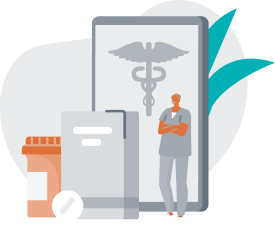Your immune system is your body’s natural defense against illness. But when it’s not working properly, even common viral infections can become more serious. Having an immunodeficiency can make things a little more complicated.
There are two main types: primary and secondary. While they may sound similar, they can have very different causes and treatment needs. Knowing the difference is an important first step toward managing your health with confidence.
What Is Immunodeficiency?
Immunodeficiency happens when your immune system isn’t able to protect you the way it should. This means your body has a harder time fighting off viral or bacterial infections, and even some types of cancer.
The immune system is made up of a network of cells, tissues, and organs working together to keep harmful invaders out. White blood cells are especially important—they travel through your bloodstream, seeking out and attacking any threats to your health.
Some common signs of immunodeficiency include:
- Frequent or recurrent infections, like pneumonia, bronchitis, or ear infections
- Infections or inflammation in internal organs
- Blood issues, such as low platelet counts or anemia
- Digestive problems, including cramping, nausea, or diarrhea
- Delayed growth or development in infants and children
Whether primary or secondary, immunodeficiency often involves repeated infections and slower recovery times. But with a personalized care plan, these challenges can be managed, and you can feel more empowered in your health journey.
Primary Immunodeficiency 101
Primary immunodeficiency disorders occur when part of the immune system is either missing or doesn’t work as it should. Most of these disorders are genetic, meaning they are inherited from one or both parents. In fact, there are over 200 different genetic defects that can lead to a primary immunodeficiency.
The immune system’s job is to protect the body from recurrent infections by recognizing and attacking harmful invaders like bacteria, viruses, and fungi. In people with primary immunodeficiency, some parts of the immune system aren’t functioning properly, leaving them more vulnerable to infections.
There are six main groups of primary immunodeficiencies, based on which part of the immune system is affected:
- B cell (antibody) deficiencies
- T cell deficiencies
- Combination B and T cell deficiencies
- Defective phagocytes
- Complement deficiencies
- Unknown (idiopathic)
Most primary immunodeficiencies are inherited through genetic defects, which can affect either a single gene or multiple genes that help control the immune system. These genetic changes are then passed from parent to child.
Some of the most common primary immunodeficiency disorders include:
- X-linked agammaglobulinemia (XLA)
- Common variable immunodeficiency (CVID)
- Severe combined immunodeficiency disease (SCID)
- Chronic granulomatous disease (CGD)
- Hyper-IgM syndromes
Secondary Immunodeficiency 101
On the other hand, secondary immunodeficiency is more common than primary immunodeficiency.
Unlike primary immunodeficiency, which is genetic, secondary immunodeficiency is acquired later in life and is caused by either health conditions or external factors that weaken the immune system.
Several things can lead to secondary immunodeficiency, such as:
- Malnutrition
- Aging
- Certain medications (like chemotherapy, corticosteroids, and immunosuppressants)
- Infections (like HIV/AIDS)
- Cancers (like leukemia and lymphoma)
- Autoimmune diseases (like lupus and rheumatoid arthritis)
Examples of secondary immunodeficiency include:
- AIDS (caused by HIV infection)
- Cancers of the immune system, like leukemia and lymphoma
- Immune-complex diseases, like viral hepatitis
- Multiple myeloma (a type of cancer affecting plasma cells that produce antibodies)
Main Differences
Both primary and secondary immunodeficiencies affect the immune system, but there are some important differences between them.
Primary immunodeficiencies are genetic disorders that someone is born with, meaning they inherit the condition from one or both parents. These are usually diagnosed in children or young adults.
Secondary immunodeficiencies, on the other hand, develop later in life due to external factors like infections, medications, or other health conditions. These can occur at any age, depending on what’s causing the weakened immune system.
How Primary and Secondary Immunodeficiencies Are Diagnosed
Diagnosing an immunodeficiency disorder can be a bit complicated, but the process usually involves a mix of physical exams, reviewing your medical history, and lab tests.
For primary immunodeficiency, your healthcare provider might look for:
- A family history of immunodeficiency
- Severe, unusual, or recurrent infections
- Poor growth or unexplained weight loss
- Recurring infections, like pneumonia, ear infections, or sinusitis
- The need for multiple rounds of antibiotics, or even IV antibiotics, to clear infections
For secondary immunodeficiency, signs might include:
- Recurring infections after starting a new medication
- Infections that are more severe or last longer than expected
- Development of an autoimmune disorder or cancer
To confirm a diagnosis, providers may use several diagnostic tools, including:
- Blood tests to measure antibody levels and check the presence of immune cells
- Prenatal tests like chorionic villus sampling or amniocentesis (if genetic immunodeficiency is suspected)
- Evaluations of how well your body responds to vaccines
While the process can feel overwhelming, remember that with the right tests and guidance, you’ll have the support needed to understand your health and take the next steps toward managing your condition. You’re not alone in this.
Treatment Options for Primary and Secondary Immunodeficiencies
Treating immunodeficiencies varies depending on the type and severity of the disorder. The main goal is always to strengthen the immune system and help prevent infections.
Treatment for Primary Immunodeficiencies
For primary immunodeficiencies, treatment options may include:
- Immunoglobulin (IG) therapy: This involves regular infusions of antibodies to help your body fight off infections. It’s a common treatment for both primary and secondary immunodeficiencies.
- Stem cell transplantation: In more severe cases, stem cell therapy may be used to rebuild the immune system.
- Gene therapy: This innovative treatment approach aims to correct the genetic defects that cause the immunodeficiency.
Treatment for Secondary Immunodeficiencies
For secondary immunodeficiencies, the focus is on treating the underlying cause. For instance:
- If the immunodeficiency is due to medication, stopping the medication may reverse the condition.
- In cases caused by malnutrition, improving nutrition can strengthen the immune system.
- If an infection like HIV is the cause, treating the infection can help restore immune function.
Lifestyle Tips for Managing Immunodeficiencies
Alongside specific treatments, people with immunodeficiencies can also take steps to reduce the risk of infections and complications:
- Practice good hygiene by washing your hands regularly
- Avoid close contact with those who are sick
- Stay up-to-date with vaccinations
- Eat a nutritious, balanced diet
- Get regular exercise to keep your body strong
Adopting these lifestyle habits, sticking to prescribed immunology treatments, and keeping up with health monitoring can help you manage your condition and stay healthy. You’re not alone on this journey, and with the right care, you can live a full and healthy life.
Living With an Immunodeficiency
Living with an immunodeficiency can feel overwhelming at times, but with the right care and support, many people with these conditions can still live active and fulfilling lives. It’s all about taking the right precautions and staying on top of your health.
Daily Precautions to Stay Healthy
Here are some simple daily steps that can help you stay as healthy as possible:
- Avoid Close Contact with Sick People: Reduces the risk of catching infections that your immune system may struggle to fight.
- Practice Good Hygiene: Wash your hands regularly and keep surfaces and your environment clean to help prevent infections.
- Stay Up-to-Date on Vaccinations: Vaccines can provide extra protection against infections and help support your immune system’s ability to fight off illnesses.
- Eat a Healthy Diet: A balanced diet strengthens your immune system. Include plenty of fruits, vegetables, and proteins to support overall health.
- Get Regular Exercise: Helps improve overall health and strengthens your body. Even light exercise can help you feel better and more energetic.
Regular Check-ups and Communication with Your Provider
It’s important to stay connected with your healthcare team. Regular check-ups are essential for managing your condition and keeping your immune system in the best shape possible.
You should reach out to your provider if you experience any of the following:
- A Fever: Can be a sign that your body is fighting an infection. Contact your provider if the fever is persistent or severe.
- Signs of Infection: Redness, swelling, or pus might indicate an infection that needs attention. If symptoms worsen or don’t improve, let your provider know.
- Exposure to Someone with a Serious Infection: If you’ve been around someone with a contagious illness, it’s a good idea to inform your provider. Your provider might recommend specific actions to take or watch for symptoms.
- Not Responding to Treatment for an Infection: If an infection isn’t improving with prescribed treatments, reach out to your provider. It’s important to adjust treatment or get additional care if needed.
Moving Forward with an Immunodeficiency
Living with an immunodeficiency can feel overwhelming at times, whether it’s something you’ve been dealing with from birth or something that has developed later in life.
While primary and secondary immunodeficiencies present different challenges, the good news is that with the right care and support, you can still live a full and active life. It’s not always easy, but many people with immunodeficiencies find ways to thrive, thanks to treatments like immunoglobulin (IG) therapy and other therapies that help strengthen your immune system.
At California Specialty Pharmacy, we’re here to offer not just treatment, but a compassionate approach to your care. We understand the challenges you face and are committed to helping you through this journey with the support you need.
Contact California Specialty Pharmacy today to learn more about how we can support you through your journey toward better health.
Frequently Asked Questions (FAQ):
What is the difference between primary and secondary immunodeficiency?
Primary immunodeficiency is genetic and present from birth, often inherited. Secondary immunodeficiency develops later due to factors like infections or medications.
What is an example of a secondary immunodeficiency?
An example is HIV/AIDS, which weakens the immune system and makes it harder for the body to fight infections.
What are examples of primary immunodeficiency?
Severe Combined Immunodeficiency (SCID) and Common Variable Immunodeficiency (CVID) are both genetic disorders that affect the immune system’s ability to protect the body.
References:
- Ballow M, Sánchez-Ramón S, Walter JE. Secondary Immune Deficiency and Primary Immune Deficiency Crossovers: Hematological Malignancies and Autoimmune Diseases. Front Immunol. 2022 Jul 18;13:928062. https://pmc.ncbi.nlm.nih.gov/articles/PMC9340211/
- Justiz Vaillant AA, Qurie A. Immunodeficiency. StatPearls. 2023 Jun. https://www.ncbi.nlm.nih.gov/books/NBK500027/
- Chorionic Villus Sampling for Prenatal Diagnosis. Cleveland Clinic. 2024 Aug. https://my.clevelandclinic.org/health/diagnostics/4028-chorionic-villus-sampling-for-prenatal-diagnosis
Legal Disclaimer: The content provided on this blog is for informational purposes only and is not intended to serve as medical advice, diagnosis, or treatment. While we make every effort to provide accurate and up-to-date information, the details shared here should not be considered a substitute for professional medical consultation or advice.
By accessing this blog, you agree to hold harmless the author, publisher, and any associated parties from any claims, liabilities, or damages arising from the use or interpretation of this content.
©2025 California Specialty Pharmacy, LLC. All rights reserved.

